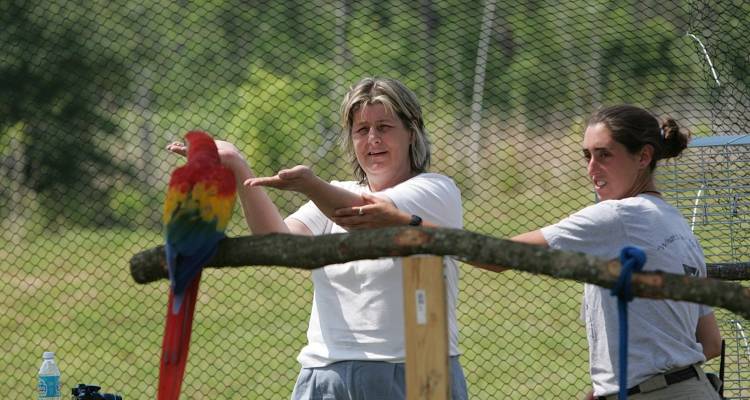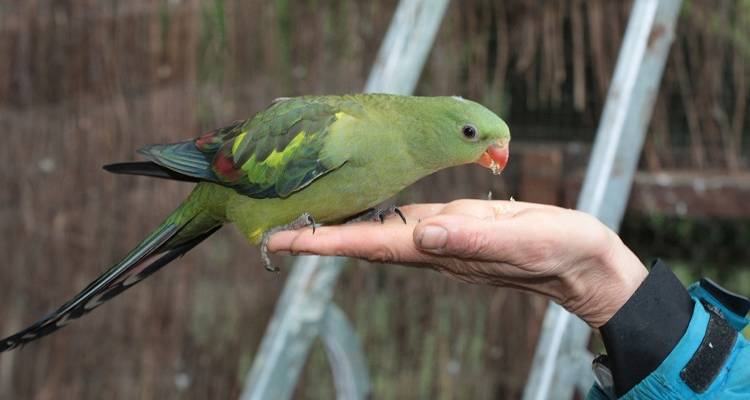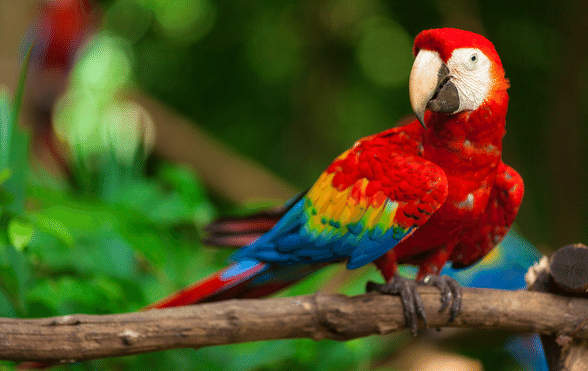Known as ‘Step Up’, you can easily train your parrot to step up onto your hand. Dot Schwarz’s latest article talks through how you can do this.
Is your parrot insured? Get a quote for up to £5,000 of vet fee cover, death and theft cover | We’ve been insuring exotic pets since 1996 | Check out our customer reviews on Feefo.
Training a parrot to step up | The step up request or command | Negative reinforcement | Hand positions | Teaching step down | How to take a parrot that bites | Teaching laddering | Should you let your parrot on your shoulder? | Training toys | Rescue birds and target training | Security during training | Your parrot won’t step up
Whether you own an African Grey, Macaw, Cockatoo, Eclectus or any other kind of parrot, training your parrot to step up onto your hand is the first behaviour she will learn. It helps your parrot to trust you.
You need a pet bird to perform this basic behaviour reliably. Without step-up you cannot move the bird from one place to another; you cannot put it in a crate. Your social interactions with it are severely limited.
A novice bird for example may have been hand reared or parent reared by a breeder. If you are wise and lucky enough to choose a conscientious breeder the chick will already have learned to trust people and possibly know the basic command of step up and step down. If it doesn’t you start from scratch.
Other articles by Dot include: How and why do parrots talk – teaching your parrot to talk
Training a parrot to step-up
-
- What you want to happen: You approach your parrot, perched on a chair-back or a training perch or in the cage. Stretch out your hand towards her and say ‘step up’The parrot puts out its right or left claw (depending on whether it is right-clawed or left-clawed) upon your hand, steadies herself (she may use her beak to balance) and places the second claw next to the first. You can then carry the bird somewhere else.

-
- What will probably happen: You present your hand, the bird shuffles along the perch away from you; if it can fly, the bird flies somewhere else. Meaning you’re left standing there empty handed and it doesn’t feel good.
So, can you create a situation where the former always happens the latter almost never? I believe you can.
-
- There are two hand positions: Palm vertical so that the bird steps onto the forefinger as if it were a branch and palm horizontal.Barrett Watson uses palm vertical. Steve Martin at Natural Encounters Incorporated uses palm horizontal, which proves my view that asking various experts gets you differing answers.
But the essential message that modern trainers give you is that positive reinforcement training – also called reward training – is now the favoured method.
The right position for your hand is directly in front of the bird and higher than the level of the perch. How much higher is a matter of judgement.
Obviously, the longer the bird’s legs, the larger its claws, the wider the distance will be. The distance never needs to be more than a few centimetres.
- There are two hand positions: Palm vertical so that the bird steps onto the forefinger as if it were a branch and palm horizontal.Barrett Watson uses palm vertical. Steve Martin at Natural Encounters Incorporated uses palm horizontal, which proves my view that asking various experts gets you differing answers.

- Don’t get too close to the bird – try to ‘think like a parrot’. In their eyes we are huge creatures with eyes in front of our faces like hawks, rats and other predators.So position yourself so that you don’t crowd your companion. Stretch out your hand slowly and in your other hand keep the treat – a favourite snack, a nut or a toy. You may show the bird the treat as a lure but once training has progressed you keep the treat hidden.
Birds make rapid movements themselves but they prefer us to use slow steady ones.
- Hand height: Always and I mean always, place your hand, whether vertical or horizontal, slightly higher than the bird’s claws. Because of their body shape, it is much easier for a bird to step higher than to step lower.If you watch birds carefully, they avoid stepping down. If you hold your hand lower than the perch, the bird is reluctant to step down. Raise your hand to her lower chest level and she will step up (willingly I hope). Then the treat is offered.
Teaching step down
Are you finding the bird is now stepping up and but reluctant to step down? A simple explanation may be that you are placing the bird slightly above the perch you want him to step onto. Step down should really be called step off. Hold the bird a few centimetres below the perch and you will find she steps up onto it with more confidence.
Is your parrot insured? Get a quote for up to £5,000 of vet fee cover, death and theft cover | We’ve been insuring exotic pets since 1996 | Check out our customer reviews on Feefo.
Teaching laddering
Once the bird steps up you may ask him to step from one hand to another. Holding the new hand above the other. The procedure is called laddering. It makes the bird concentrate.
I don’t like it because it seems to me that you are asking the bird to repeat the step up unnecessarily.
Your parrots beak and balance – its not always biting
If your parrot is biting you while training, she may not be doing it on purpose. Parrots use their beak to balance, and don’t mean to bite. If you pull your hand back suddenly, your parrot could become confused – which could lead to step up problems.
How to tame a parrot that bites
Biting is almost unknown among wild birds. It is result of captivity. For more information about biting in parrots read my article Biting and feather plucking in parrots
Signs of an imminent bite include: eye pins; shuffling along the perch; neck slicked, or feathers roused.
In those situations you should:
- Back off and wait for the bird to calm down
- Keep calm, do not punish your bird. A raised voice, or any punishment will make the situation worse. She will also become frightened of you
- Remain patient, and return to the parrot once she’s calmed down
- You could practice ideas from Positive Reinforcement, where you reward her positive behaviour but ignore her negative behaviour. This will help to reinforce that you don’t like her biting you
- Above all, do not get angry or punish your parrot
It is a sad fact that many rescue birds, especially cockatoos, have learned that biting makes the frightening hand go away. But patience and setting up the environment to ensure success can produce amazing results.
Teaching step up using target training
Teach a bird to touch a target stick and then use that stick to get the bird to move around.
You can buy specially made target sticks or use a wooden dowel or a chopstick. Hold the target in one hand so you have the other for treats.
Show the bird the stick and reward her for looking at it. Soon she will grab the stick. Then you have to get it back but give the reward. The bird realises that it must only touch the target. Once a bird is habituated to targeting it will move from one place to another to touch the stick and get the reward. It won’t take more than a few sessions for the parrot to twig what targeting is all about.
You should still use the same methods as mentioned above, alongside the target stick.
Case Study: Monty a three year old grey
Monty came here when his owner died. He was used to being handled only by one person. Monty knew no requests and lunged nastily. He soon learned to touch the target stick and obtain a sliver of almond, his favourite treat. Then I could lay another stick alongside the target and Monty wold perch on that. This meant I could put him in his cage easily without resorting to chasing, towelling or netting.
Rescue birds and target training
A few of my birds are wild caught or rescues, who have had traumatic events in their lives and for them, I do not know why, somehow target training appears less stressful than asking for the step up straight away.
Once a bird is moving freely to the target, I simply lay the target stick alongside my hand. The bird touches that for the reward. It does not take long then for the stick to be on my hand and the bird performing a step up that way.
Your parrot won’t step up
Clare Bugden, a parrot friend and I were discussing this topic. Clare remarked that she sometimes noticed Mambo, her 4 year old Greening macaw was, on occasion, reluctant to step up. She analysed two reasons which I find apply to most of us.
The first one she said was that step up meant being put back into the cage where he didn’t want to go. I find the same with Benni, the 2-year old macaw, who, when I ask for step up at bedtime, flies onto the picture rail. I have to stand on a chair to get him down.
I’ve altered this scenario by delaying his bedtime an hour later when he is actually not unhappy at going to bed.
Clare’s other point was realising that sometimes she was feeling stressed or anxious and the macaw responded to that by avoiding her. It is sound practice not to interact with your birds when you are upset anxious or angry; their response will be diminished.
The goal for a good step up is that the parrot moves towards you, she is expecting a pleasant experience and a reward for complying with your request. ‘Step- up, good bird’
Negative reinforcement and your parrot
Almost twenty years ago, I got from my first African Grey (Erithacus Erithacus) from Barrett Watson a reputable parrot breeder and advocate of pet insurance.
Artha – a hand reared chick coming to me at 14 weeks old – knew step up. However, she had been trained by having a hand held against her chest and pressure applied until she stepped up onto it. This method using what is called negative reinforcement (NR) means that the bird steps up to avoid the pressure.
Teaching methods using negative reinforcement (aspects of punishment) are no longer recommended.
It is interesting though to acknowledge that although Artha was initially trained using an NR strategy, it has not resulted in her developing any fearful or aggressive habits. Why not? Because the rest of her interactions with Barrett and later with me and my family were only positive and benign.
She has developed the habit of trust with her human caregivers. (More of trust later)
Case Study: two wild caught Timnehs
Sid, untrained but non-biting, had been alone in a cage for twelve years. He was lame from an untreated broken leg.
Holding my left hand flat with a desirable sunflower seed visible in the right one, enabled him within a couple of weeks to step up.
Once he did that his life was greatly improved as I could take him out of the shed into the aviary and he could enjoy sunshine.
Mirt, a much older hen, was terrified of hands. Released into our aviary, she relearned to fly in a few weeks, after eight months shut in a box.
If touched, she bit. To catch her meant using a net. It took almost two years before she learned to trust me and others, to step up and fly to the hand on cue. Interacting with her on a daily basis was so rewarding.
Security during training
You may choose to train in a designated room like the bathroom where there are less distractions. Or you may use the room where the bird normally lives. Wherever it is, you make sure windows and doors are shut, ceiling fans are off and other pets elsewhere.
My tip for preventing novice birds, fledglings or birds that have been tightly caged from flying into windows is to smear Windolene over the glass. It only takes a few days or at most a few weeks for the birds to learn that the transparent glass is solid. I rub off the Windolene day by day, ending up with nice clean mirrors and windows.
Other trainers may use masking tape. I taught young Artha Grey not to fly into windows by that method. It wasn’t fool proof. The first time she visited a friend’s flat with French windows she banged into one.
Wild birds can kill themselves on exterior glass. Indoor birds don’t get up enough speed to injure themselves badly. Another method with a hand trained bird is to take it round the house and tap its beak on all windows and mirrors.
Should you let your parrot on your shoulder?
Most trainers will tell that you should never allow the bird on your shoulder because:
- You cannot see what the bird is up to
- It is too near your face should it try to bite
However, that said, you will often see pictures of the same trainers with a bird on their shoulder. Many of us who have birds that we trust let them on our shoulders.
Case study: Benni macaw (Ara Ararauna)
Benni was hand fed from five weeks old. I was determined not to let him scoot up to my shoulder whenever he sat on my lap. He learned step up at sixteen weeks old. But in the daily battle of removing him from my shoulder Benni won.
“Each bird is the study of one” says Susan Freidman, one of the world’s foremost proponents of positive reinforcement teaching. And so in each individual case you have to decide. Whatever your decision stick with it.
Is your parrot insured? Get a quote for up to £5,000 of vet fee cover, death and theft cover | We’ve been insuring exotic pets since 1996 | Check out our customer reviews on Feefo.

